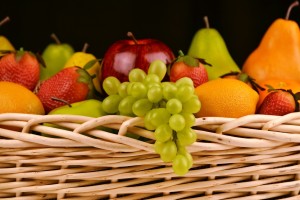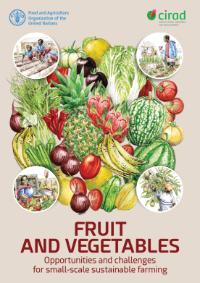
New publication provides an overview of challenges and opportunities for small-scale farmers
 Rome/Montpellier: There are 690 million undernourished people living in the world today, 750 million people suffering food insecurity, 2 billion people lacking access to safe and nutritious foods and 3 billion people unable to afford a healthy diet.
Rome/Montpellier: There are 690 million undernourished people living in the world today, 750 million people suffering food insecurity, 2 billion people lacking access to safe and nutritious foods and 3 billion people unable to afford a healthy diet.
A new publication, Fruit and Vegetables: opportunities and challenges for small-scale sustainable farming, jointly launched today by the Food and Agriculture Organization of the United Nations (FAO) and the Centre de Coopération Internationale en Recherche Agronomique pour le Développement (CIRAD), reports that the burden of malnutrition in all its forms poses a significant challenge to those who suffer it.
According to estimates from 2019, 21.3 percent (144 million) of the world’s children under 5 years of age were stunted, 6.9 percent (47 million) were wasted and 5.6 percent (38 million) were overweight. Diets in low-income countries rely more on staple foods and less on fruit, vegetables and animal proteins than in high-income countries.
While vitamin, mineral and fibre-rich, fruit and vegetables are vital for nutritious diets, and the sector contributes to increasing biodiversity and improving livelihoods, the book mentions that it faces numerous challenges in production, transport and trade that lead to high prices, making fruit and vegetables inaccessible to many, especially in low- and middle-income countries.
To achieve the Sustainable Development Goals (SDGs), empowering small-scale farmers in low-middle -income countries to increase their production of safe and nutritious fruit and vegetables in ways that protect the environment, generate income, and create social equity is a priority.
However, fruit and vegetables are highly perishable products, which can result in loss and waste, and given that many are consumed raw or uncooked, they may also pose a risk for foodborne illnesses. Furthermore, inappropriate pest and disease management of crops can lead to food safety and trade risks due to pesticide contamination or pest introduction.
The publication offers guidance to small-scale farmers when starting-up or expanding fruit and vegetable production and is the result of a three-year effort coordinated by FAO and CIRAD with contributions from over more than 200 leading experts.
The vast diversity of fruit and vegetable crop species and their varieties offer numerous opportunities for small-scale farmers to produce nutritious and high-value crops in their rural, peri-urban, and urban environment, using relatively small areas of land. Market liberalization and growth in international trade too have created export opportunities for the horticultural sector in many countries.
In parallel, rapid urbanization and income growth have led to increased consumption of horticultural produce, thereby expanding opportunities for small-scale producers and other stakeholders in horticultural food systems.
The book convinces the reader to care about fruit and vegetables and to see that the small-scale production of these crops is fundamental to achieving sustainable development goals. In five chapters, the reader learns about the challenges and rewards for producers, sellers, and consumers.
The publication is based on proven, practical experiences and highlights 14 case studies from around the world. These include: the grafting technique applied to vegetables in Viet Nam to prevent bacterial wilt and to tolerate flooding of tomatoes; successful agro-forestry systems in Brazil’s Amazonian region; the use of biological techniques to control fruit flies on the island of Réunion; and the acquisition and management of big data to help small-scale mango farmers in Senegal.
“Fruit and vegetables make an important contribution to achieving multiple Sustainable Development Goals” said FAO Deputy Director-General, Beth Bechdol. “Knowledge products and strategic and transformative partnerships like the ones being presented today will put us on the right track us to achieve the SDGs, with a focus on better production, better nutrition, a better environment and a better live, leaving no one behind” she added.
CIRAD Chief Executive Officer Elisabeth Claverie de Saint Martin stressed the merits of the partnership between FAO and CIRAD and called for more investment in horticulture, the “poor relation in terms of agricultural research […] The horticultural sector will be vital in pushing ahead with an agroecological transition that combines the idea of “One Health” and territory-based approaches. We need to sustain and indeed increase investment in this field”, she added.
Martin also highlighted the synergies of science-based development resulting from the strategic partnerships between the convening power of FAO and the technical excellence of CIRAD. “CIRAD considers horticulture to be a prime sector for studying an agroecological transition, integration into the concept of ‘One Health,’ and a territorial approach – three challenges also targeted by FAO,” she stated.
Challenges posed by the perishability of fruit and vegetables are addressed by in the book with examples of appropriate technologies for the production and post-harvest management of high quality and safe fruit and vegetables. These in turn provide opportunities for new, off- farm businesses and decent work for advisory, technical, and marketing services and help reduce food losses.
– global bihari bureau





